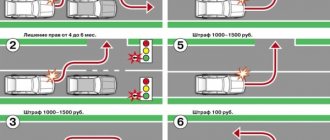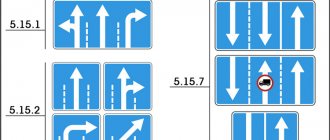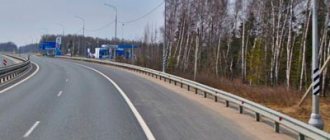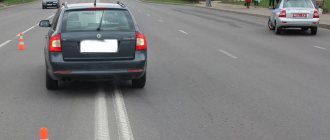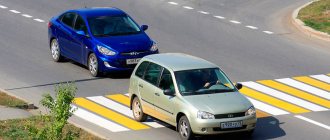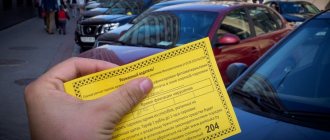At what speed can you overtake a slow moving vehicle?
The maximum speed set by the manufacturer is no more than 30 km/h .
Someone can’t stand it and breaks it, overtaking through a continuous line. Why does it violate? Because there is no sign on the slow-moving vehicle that it is a slow-moving vehicle (there should be a sign in the form of a triangle).
If this is a traffic police setup, the so-called “Korobochka”, then a traffic police crew is already waiting for such a driver a little further away, or the same traffic police crew is trudged along in a common column, waiting for the most impatient. One of these guys was caught when he started overtaking across a clear line. The traffic police crew turned on the flashing lights straight from the convoy and went to catch up with him.
If only there was a slow-moving sign, you could overtake through a continuous road, but that’s prohibited! But in such a situation, when a line of cars has accumulated behind such transport, he must pull over to the side of the road and let everything pass. But who does that? I personally have never seen it. But I have seen a hundred times how such “slow movers” are forced to violate traffic rules.
Fine for violating overtaking rules
What is the punishment for overtaking under the sign “Overtaking is prohibited”, you can find out from Article 12.15 of the Code of Administrative Offenses of the Russian Federation. In this case, the driver faces a fine of 5 thousand rubles or deprivation of rights for 4-6 months. Please note that due to innovations in the traffic rules of 2014, the rules for obtaining rights after deprivation have also changed. To return a document, you must pass a theoretical exam on knowledge of the rules of DD. If, when overtaking, the driver leaves his lane, then he faces a fine for crossing a double solid line - from 500 rubles to 5 thousand rubles.
Overtaking a slow-moving vehicle across a clear road
I scoured the auto forums and it turns out that many do not know what to do in such a situation. Therefore, I will formulate it briefly and clearly.
- If the vehicle is moving slowly, but there is no “slow-moving” sign, then you cannot overtake it at all.
- If there is a sign “slow-moving vehicle” and there are only continuous markings, then it is prohibited to overtake such a slow-moving vehicle through the continuous one.
- If there is a “slow vehicle” sign, there is a continuous marking 1.1 or 1.11 and there is a sign 3.20 “Overtaking is prohibited”, then overtaking is prohibited until the end of the “Overtaking” sign, except for low-speed vehicles, horse-drawn carts, bicycles, mopeds and two-wheeled motorcycles without sidecars .
Overtaking slow-moving vehicles, horse-drawn carts, bicycles, mopeds and two-wheeled motorcycles without sidecars is permitted except for sign 3.20 “Overtaking is prohibited”, and since signs have priority over markings, then we obey the actions of the signs.
Every driver could be in a situation where a slow vehicle is driving in front of him on a rather narrow road, which is very difficult to overtake according to all the rules. Everyone will probably want to get ahead of such an annoying “fellow traveler”. After all, such cars or tractors can move at speeds of up to 40 km/h.
In such a situation, almost any driver will be somewhat agitated. And so you overtake "on emotions", but then along the way there appears a car of our valiant inspectors, who, it seems, were sitting here and waiting for an oversight on your part.
Is it allowed to overtake a vehicle through a continuous lane?
It is allowed to overtake slow-moving vehicles even where there is a ban on overtaking other types of vehicles. To understand whether it is possible to overtake by crossing a solid marking line, you need to understand its purpose.
- Solid markings indicate the edges of the road where driving is prohibited.
- Indicates a stopping place before an intersection or pedestrian crossing.
- Divides the road into two opposite flows for equivalent categories of vehicles or into two passing lanes, one of which is intended exclusively for a specific type of transport (for example, buses).
A solid line has the same meaning for all types of transport, that is, you cannot cross it either in a passenger car or in a slow-moving one.
When is maneuver allowed?
Since sign 3.20 “Overtaking is prohibited” does not apply to slow-moving vehicles, you can overtake slow vehicles even within its coverage area. This is stated in the traffic rules.
Marking 1.1 (solid) and sign 3.20 do not contradict each other. However, if there is a solid line with or without a 3.20 sign, overtaking any vehicle, including slow-moving vehicles, is prohibited.
Exceptions to the rules
A slow-moving vehicle must display a placard indicating its maximum speed.
Also, this plate may be in the form of a red triangle with a yellow border. If there is no such sign, but the vehicle cannot go faster based on its design, then overtaking will not be a violation. In this case, the driver of a slow vehicle may receive a warning for inaction. An example is an asphalt roller. Its speed often does not exceed five kilometers per hour. Even if such a vehicle does not have a sign indicating its speed, it can still be overtaken. Thus, the driver will not break the rules.
The opposite situation: a tractor is moving along the road, its speed is approximately 20 km/h. If the vehicle does not have a sign attached, then overtaking it in the area covered by sign 3.20 will be a risky move. It is likely that the PTS indicates a maximum speed of 34-35 km/h. Therefore, overtaking a vehicle that gives the impression of being slow-moving, but in fact is not, will be a traffic violation, which will result in a considerable fine.
It is worth considering that installing a sign for slow moving vehicles is not always possible. For example, it is very problematic to hang it on a bicycle or horse.
Overtaking (even slow-moving vehicles) is prohibited in all places listed in paragraph 11.4 of the traffic rules:
- at intersections;
- in tunnels;
- on bridges, overpasses, overpasses and under them;
- at a pedestrian crossing;
- at railway crossings and at a distance of less than 100 meters in front of them;
- on dangerous turns, steep slopes and places with limited visibility. As a rule, such areas are indicated by signs 1.14, 1.11.1 and 1.11.2.
How to overtake a slow-moving vehicle without losing your license
It must be said that according to the rules, slow-moving vehicles are simply obliged to create conditions in order to allow cars behind them to pass, which can move at a higher but permitted speed. There is no need to be even more nervous here. Moreover, you may not be alone in such a problem.
Some “advanced” traffic cops, in general, themselves initiate the movement of such vehicles and provoke drivers to violate the speed limit. Naturally, the driver of a slow tractor who does not allow passage will not face punishment.
But you have a conversation with the inspector, which, according to “all the rules of the genre,” should end with a bribe to the traffic cop. Particularly stubborn drivers end up in court after such setups and are often at an even greater disadvantage.
Concept of a low-speed vehicle
In accordance with these rules, only those equipment whose maximum rated speed reaches 30 km/h (tractors, asphalt rollers, combines, etc.) are considered a “low-speed vehicle”.
Other vehicles that have a similar limitation due to a technical malfunction or driver inexperience are not slow moving vehicles. In order to recognize a slow car in traffic, a special sign is attached to it (on the back side), in the form of a red triangle with a yellow border. If there is no such distinctive marking on the car, but it is moving at a speed of less than 30 km/h (including without the emergency lights on), then its advance by crossing a continuous marking line will be quite controversial.
What applies to low-speed vehicles
The only low-speed vehicle recognized as such by law is the asphalt compactor. The
traffic rules do not define low-speed vehicles. It has been established that the slow movement of a car due to certain circumstances, such as damage as a result of an accident, which prevents it from developing normal speed, are not parameters of low-speed vehicles.
Slow-speed criteria can only be established by the manufacturer.
A low-speed vehicle is a mechanism that can reach a maximum speed (according to the manufacturer) of no more than 30 km/h. All information is contained in the technical passport of the car.
Effect of the "Slow Moving Vehicle" sign
The identification mark has dimensions determined by GOST, a fixed pattern. The designation is presented on slow-moving vehicles on the left side. This facilitates a quick response to the situation of the cars behind it. The sign is used as an identification element that informs about the high-speed technical features of the vehicle.
Description and requirements for the sign
Visually, a slow-moving car in the traffic police rules is illustrated in the form of an equilateral red triangle. The figure has a yellow border, as well as cuts along the edges. Due to the fundamental importance of having an appropriate image, the dimensions of the slow-moving vehicle sign are regulated by the guest.
In order for it to be clearly visible to cars passing by, the following requirements are imposed on the image parameters:
- overall dimensions should be from 350 to 365 mm;
- the width of the edging should be in the range of 45-48 mm;
- the central red base must have a fluorescent coating;
- The edging of the sign must be reflective.
It is allowed to make a sign from the following materials:
- self-adhesive film;
- aluminum;
- canvas with PVC base.
There are also a number of requirements for installing the sign:
- the mounting location must be located on the rear of the vehicle body;
- one of the corners of the triangle should be located strictly upward (a discrepancy of only 5 degrees is acceptable);
- the height of the upper part of the sign cannot exceed 150 cm above the ground;
- the lower part of the triangle cannot hang closer than 25 cm from the ground;
- the marking must be clearly visible to others; 10% overlap is allowed, but only if this is due to the design features of the road user;
- The presence of damage and defects on the sign is unacceptable.
The sign can be attached using screws, rivets and double-sided tape. The image of the red three-sided figure on the vehicle appears in only one place - the left side of the rear body of the car. Additional duplication of the symbol in other places on the body is unacceptable.
If there is no red-yellow triangle symbol on the slow-moving vehicle, traffic police officers have the right to fine the violator.
Designation dimensions
The sign “Slow-moving vehicle” has the following dimensions of the sides of a regular (in other words, equilateral) triangle: 350-365 mm. It is important that the parameters of not only the designation itself, but also its edging, comply with state standards. So, for the border of the “Slow-moving vehicle” sign, the dimensions according to GOST are the permissible width within the range of 45-48 mm. Let's move on to the installation and fastening rules.
Installation of designation
The “Slow-moving vehicle” sign is placed in such a way that all its characteristics must be preserved with minimal concessions - only covering no more than 10% of its surface with non-removable structural parts of the vehicle is allowed. During operation of a low-speed device, it is necessary to prevent the identification triangle from being affected by manufacturing and design defects.
The fastening, accordingly, must be strong and static - the use of rivets, screws, and special double-sided tape is allowed. It is important to provide easy access to the outer surface of the sign to periodically clean it from dirt.
Accommodation and layout
When placing a sign, be sure to place it strictly with one side of the triangle facing up. In relation to the transverse vertical beam - only at an angle of 90 degrees to the longitudinal axis of the vehicle. Deviation within 5 degrees is allowed.
The designation must be presented only in the singular and located on the side of the vehicle (right or left) that is opposite to the direction of traffic in a given country.
The lower level of the symbol must be no lower than 25 mm above the ground surface, and the upper level must be no more than 150 cm above it.
Legal standards
The sign must be installed at the rear of all mechanical vehicles for which its manufacturer has determined the highest speed, not exceeding 30 km/h.
The “Slow Moving Vehicle” sign is reflected in the following legal documents:
- Technical regulations of the Customs Union 018/2011. Vehicles belonging to categories M, N, O, the highest design speed of which is not more than 40 km/h, are required to be marked with this designation.
- Federal Law of the Russian Federation No. 77. Regulation of fines for drivers of slow-moving vehicles.
- Traffic rules 11.6. The rules require that in conditions where overtaking a device equipped with a “Slow Moving Vehicle” sign is difficult or impossible, the driver of it should stay to the right or even stop if necessary to let the following high-speed vehicle pass.
- Code of Administrative Violations (Article 12.15, Part 1, Clause 1.1). Introduction of a fine for the owner of a low-speed vehicle (travelling less than 30 km/h), who did not provide the driver of a faster vehicle with the opportunity to overtake, in the amount of 1-1.5 thousand rubles.
- Code of Administrative Offenses of the Russian Federation (Article 12.15). In the spring of 2021, another penalty was introduced for drivers of slow-moving vehicles - 500 rubles for driving without an identification marking.
Polysemy of the concept
When passing the theoretical part of the driver's license exam, many people make the mistake of choosing the wrong low-speed vehicle in the test. Relying on intuition, future drivers include here vehicles that, logically, cannot reach high speeds - a bicycle, a horse-drawn cart, a tractor. However, in some tests this question is somewhat complicated: the photo for the task shows a racing bicycle, sports competitions involving horse-drawn carriages, etc. So what should you choose?
The issue is resolved very simply. Only those vehicles that have the appropriate sign can be considered slow-moving. Without it, even a tricycle and an antediluvian cart cannot be called a slow-moving vehicle.
Invite a slow-moving driver!
In such a situation, the other driver should politely explain that he and you become a violator. If something happens, you will be forced to make sure that he also pays the appropriate fine. Such a statement is perceived very critically in a set-up situation, and the “thoughtful” driver is simply released and the hunt continues.
If you are not alone and several cars have accumulated behind a slow-moving vehicle, then according to the rules such a vehicle is obliged to periodically stop and let other cars pass ahead. In this situation, the fake driver will admit this and you will be released in peace.
When is it permissible to overtake a slow-moving vehicle?
The amendments made to the overtaking rules apply only to the “No Overtaking” sign.
Its effect applies to all types of vehicles, with the exception of motorcycles without sidecars, mopeds, bicycles, horse-drawn leashes and slow-moving vehicles. In the absence of this limiter, driving on a two-lane highway with solid marking lines 1.1 or 1.11 is subject to the same set of rules and wording as before.
There are four main cases in which we can talk about permission or a ban on overtaking a slow-moving vehicle:
- If driving together with a slow-moving vehicle occurs in the area of the “Overtaking is prohibited” sign, then, in accordance with the changes, overtaking a slow-moving vehicle is allowed through a continuous road.
- There are 1.1 or 1.11 markings on the road, but there is no sign regarding overtaking. This means that the amendments do not apply, and drivers driving behind a slow-moving vehicle are not allowed to overtake a slow-moving vehicle through a continuous road.
- There is a 3.20 sign, and there is also a 1.1 or 1.11 marking. Here, as in the first paragraph, overtaking a slow-moving vehicle through a continuous marking line is permitted.
- In the event that overtaking a vehicle is prohibited by any means other than sign 3.20, it is prohibited to overtake a slow-moving vehicle or any other vehicle. Amendments and exceptions do not apply here.
Overtaking a slow-moving vehicle may be prohibited if, for example, there are tunnels, bridges or other places with poor visibility. Or in a situation where there is at least one other vehicle in front of a car that wants to overtake and a slow-moving vehicle that is not overtaking.
The changes made to the traffic rules in 2015 had nothing to do with the issue of overtaking slow-moving vehicles, so at the moment it is the 2012 amendments that are relevant.
Penalty for illegal overtaking
If you are in a situation where you really want to overtake a slow-moving vehicle, it is worth taking a closer look, since it will not always be a slow-moving vehicle. However, if you know for sure that the vehicle in front of you has a maximum speed that does not exceed 30 km/h, then such a vehicle can be overtaken.
But you should be careful with this, otherwise you can earn a fine of 5,000 rubles regulated by Article 12.15 of the Code of Administrative Offenses, Part 4 for overtaking while crossing a solid line with possible deprivation of your driver's license.


